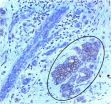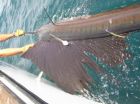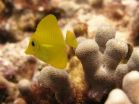(Press-News.org) University Park, Pa. -- A computer program that automatically analyzes mounds of satellite images and other data could help climate scientists keep track of complex, constantly changing environmental conditions, according to an international team of researchers.
"All of the data and information that is continually collected by satellites and sensors can cause tons of problems for scientists, who simply don't have the time to analyze every pixel of every satellite image," said James Wang, professor of information sciences and technology, Penn State. "Our goal has been to provide a tool that would create useful information or knowledge from this large pool of data.."
The program uses probability to analyze and extract environmental information from satellite images and sensor data about ocean structures like wakes, upwellings and cold and warm eddies, the researchers reported in the current issue of IEEE Transactions on Geoscience and Remote Sensing.
Researchers first built a database of ocean structures and then used the knowledge of human experts to train the program to recognize and identify changes in the ocean.
"We're particularly interested in the analysis of mesoscale regional ocean structures in satellite images," said Jose A. Piedra-Fernandez, a visiting professor in information sciences and technology at Penn State during the project and currently an assistant professor at the University of Almeria, Spain.
Researchers tested the technology on satellite images provided by the National Oceanographic and Atmospheric Administration and the Advanced Very High Resolution Radiometer of sections of oceans in the Iberian Atlantic, the Mediterranean coast and near the Canary Islands. The tests included 1,000 cases of real ocean features, including 472 upwellings, 119 cloudy upwellings, 180 wakes, 10 anticyclonic eddies, 40 cyclonic eddies and 180 misclassified regions.
The best combination of filter and classification method developed by the researchers accurately identified the ocean features more than 89 percent of the time.
"In almost all cases, the proposed methodology improves the accuracy rate and reduces the number of features necessary to get a good ocean structures classification," Piedra-Fernandez said.
The researchers think that data on these oceanic features could offer clues on subtle changes in the temperature of the oceans and global climate conditions.
The system involves several steps, including adjusting for possible earth- and solar-based interference sources, separating ocean regions from land regions and extracting and identifying features from specific regions of ocean. In the feature selection process, the system filters the regions of the images by ranking strong and weak--or, relevant and irrelevant--relationships between the features, said Piedra-Fernandez. After the filtering process, the system can better identify and classify the upwellings, wakes and eddies.
Bayesian networks, which use probability to make decisions, are the preferred technology for classifying the features because they are easy to design and evaluate, said Piedra-Fernandez. Just as the presence of sniffles and a cough increases the probability that a doctor will diagnose that a patient is suffering from a cold, a Bayesian network can determine that the color or shading of certain pixels in an image indicates an upwelling, or other oceanic features studied by the researchers.
Because the design of the Bayesian system requires less data for learning than other probability-based decision systems, such as Markov networks, the Bayesian networks reduce the computational cost of the system, another key goal for the system's design.
The team next plans to add more features, such as salinity and chlorophyll concentrations, and improve the accuracy of the image classification system.
INFORMATION:
Wang and Piedra-Fernandez worked with Manuel Canton-Garbin, professor of computing and artificial intelligence, University of Almeria, Spain.
This project was partially supported by Spain's Ministry of Education and Science. Their ongoing research is funded by the National Science Foundation's cyber-enabled discovery program.
Researchers train software to help monitor climate change
2010-12-23
ELSE PRESS RELEASES FROM THIS DATE:
Measuring fatigue through the voice
2010-12-23
WASHINGTON, D.C., December 22, 2010 -- What can scientists learn from watching a group of people sitting around, chatting, playing movies, reading, and happily making new friends? Quite a lot, says University of Melbourne, Australia acoustician Adam Vogel, who carefully observed this sort of group in a fatigue management study he and his colleagues describe this month in The Journal of the Acoustical Society of America.
Their report shows the effects of sustained wakefulness on speech and describes a novel method to acoustically analyze the effects of fatigue on the central ...
AADR testifies to the FDA advisory panel on dental amalgam
2010-12-23
Gaithersburg, MD – On December 14-15, 2010, the U.S. Food and Drug Administration (FDA) convened an Advisory Panel to discuss several scientific issues that may affect the regulation of dental amalgam. At the conclusion of the hearing, the Panel voted to recommend that the FDA conduct further review of the material's safety.
The meeting comes on the heels of a July 2009 Final Rule (http://bit.ly/FDA2009FinalRule) from the FDA that reclassified dental mercury from a class I device to a class II device and designated special controls for dental amalgam, mercury and amalgam ...
Penn researchers identify potential target for breast cancer therapy
2010-12-23
PHILADELPHIA – Overexpression or hyperactivation of ErbB cell-surface receptors drives the growth of many breast cancers. Drugs, like Herceptin, that block the receptors' signals halt tumor progression in some patients. However, not all patients' tumors respond, with some becoming resistant over time. Different drugs that interfere with other steps in the signaling pathway may improve the response of patients, yet little is known about these molecules.
Now, Marcelo G. Kazanietz, PhD, professor of Pharmacology at the University of Pennsylvania School of Medicine and colleagues, ...
New annotated database sifts through mountains of sequencing data to find gene promoters
2010-12-23
Researchers at The Wistar Institute announce the release of an online tool that will help scientists find "gene promoters"—regions along a DNA strand that tell a cell's transcription machinery where to start reading in order to create a particular protein. The Mammalian Promoter Database (MPromDb) integrates the genome sequencing data generated at Wistar with publicly available data on human and mouse genomics. MPromDb pinpoints known promoters and predicts where new ones are likely to be found, the researchers say.
"Several complete genome sequences are available, including ...
Genome of extinct Siberian cave-dweller linked to modern-day humans
2010-12-23
Researchers have discovered evidence of a distinct group of "archaic" humans existing outside of Africa more than 30,000 years ago at a time when Neanderthals are thought to have dominated Europe and Asia. But genetic testing shows that members of this new group were not Neanderthals, and they interbred with the ancestors of some modern humans who are alive today.
The journal Nature reported the finding this week. The National Science Foundation's Behavioral and Cognitive Sciences Division partially funded the research.
An international team of scientists led by Svante ...
Growing hypoxic zones reduce habitat for billfish and tuna
2010-12-23
Billfish and tuna, important commercial and recreational fish species, may be more vulnerable to fishing pressure because of shrinking habitat, according to a new study published by scientists from NOAA, The Billfish Foundation, and University of Miami Rosenstiel School of Marine and Atmospheric Science.
An expanding zone of low oxygen, known as a hypoxic zone, in the Atlantic Ocean is encroaching upon these species' preferred oxygen-abundant habitat, forcing them into shallower waters where they are more likely to be caught.
During the study, published recently in ...
Ever-sharp urchin teeth may yield tools that never need honing
2010-12-23
MADISON – To survive in a tumultuous environment, sea urchins literally eat through stone, using their teeth to carve out nooks where the spiny creatures hide from predators and protect themselves from the crashing surf on the rocky shores and tide pools where they live.
The rock-boring behavior is astonishing, scientists agree, but what is truly remarkable is that, despite constant grinding and scraping on stone, urchin teeth never, ever get dull. The secret of their ever-sharp qualities has puzzled scientists for decades, but now a new report by scientists from the ...
Study shows drifting fish larvae allow marine reserves to rebuild fisheries
2010-12-23
CORVALLIS, Ore. – Marine ecologists at Oregon State University have shown for the first time that tiny fish larvae can drift with ocean currents and "re-seed" fish stocks significant distances away – more than 100 miles in a new study from Hawaii.
The findings add credibility to what scientists have believed for some time, but until now been unable to directly document. The study also provides a significant demonstration of the ability of marine reserves to rebuild fishery stocks in areas outside the reserves.
The research was published this week in PLoS One, a scientific ...
University of Minnesota discovery suggests a new way to prevent HIV from infecting human cells
2010-12-23
Researchers at the University of Minnesota have discovered how HIV binds to and destroys a specific human antiviral protein called APOBEC3F. The results suggest that a simple chemical change can convert APOBEC3F to a more effective antiviral agent and that shielding of a common feature shared by related proteins may yield a similar outcome.
This discovery highlights the potential for a novel approach to combating HIV/AIDS that would seek to stabilize and harness the innate antiviral activity of certain human proteins, according to lead author John Albin, a researcher ...
Pterygotid sea scorpions: No longer terror of the ancient seas?
2010-12-23
BUFFALO, NY (December 22, 2010) -- Experiments by a team of researchers in New York and New Jersey have generated evidence that questions the common belief that the pterygotid eurypterids ("sea scorpions") were high-level predators in the Paleozoic oceans. This group, which ranged the seas from about 470 to 370 million years ago (long before the dinosaurs appeared), included the largest and, arguably, scariest-looking arthropods known to have evolved on planet Earth. Reaching lengths of 2 ½ meters with a body supported by well-developed legs, and armed with a pair of forward-facing ...



